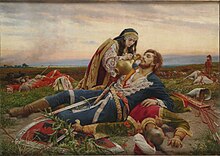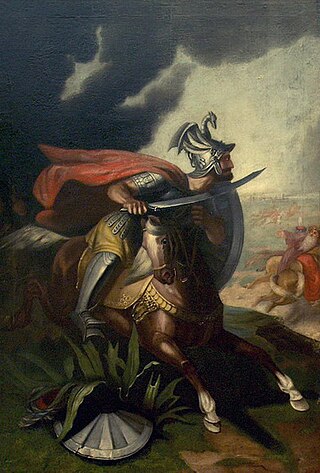
Miloš Obilić was a legendary Serbian knight who is reputed to have been in the service of Prince Lazar during the Ottoman invasion of Serbia in the late 14th century. He is not mentioned in contemporary sources, but features prominently in later accounts of the 1389 Battle of Kosovo as the assassin of Sultan Murad. Although the assassin remains anonymous in sources until the late 15th century, the dissemination of the story of Murad's assassination in Florentine, Serbian, Ottoman and Greek sources suggests that versions of it circulated widely across the Balkans within half a century of the event.

Serbian epic poetry is a form of epic poetry created by Serbs originating in today's Serbia, Bosnia and Herzegovina, Croatia, Montenegro and North Macedonia. The main cycles were composed by unknown Serb authors between the 14th and 19th centuries. They are largely concerned with historical events and personages. The instrument accompanying the epic poetry is the gusle.

Slavic mythology or Slavic paganism is the religious beliefs, myths, and ritual practices of the Slavs before Christianisation, which occurred at various stages between the 8th and the 13th century.
The gusle or lahuta is a bowed single-stringed musical instrument traditionally used in the Dinarides region of Southeastern Europe. The instrument is always accompanied by singing; musical folklore, specifically epic poetry. The gusle player holds the instrument vertically between his knees, with the left hand fingers on the strings. The strings are never pressed to the neck, giving a harmonic and unique sound.

Montenegrins are a South Slavic ethnic group that share a common ancestry, culture, history, and language, identified with the country of Montenegro.
Đerzelez Alija or Gjergj Elez Alia is a legendary character found in the epic poetry and literature of Bosnia and Herzegovina, Gora, Kosovo and northern Albania. The legendary character is believed to have been a popular Muslim epic hero of the Bosnian Krajina from the end of the 15th century. He is one of the well known legendary heroes and a symbol of brotherly loyalty to both the Bosniaks and Albanians.
Serbian literature, refers to literature written in Serbian and/or in Serbia and all other lands where Serbs reside.

Serbian culture is a term that encompasses the artistic, culinary, literary, musical, political and social elements that are representative of Serbs and Serbia.
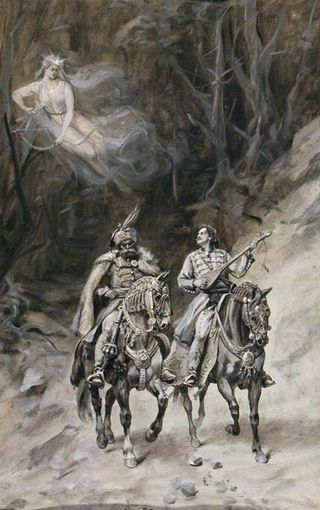
A vila, or víla is a Slavic fairy similar to a nymph.

The Mountain Wreath is a poem and a play written by Prince-Bishop and poet Petar II Petrović-Njegoš.

Albanian folk beliefs and mythological stories comprise the beliefs expressed in the customs, rituals, myths, legends and tales of the Albanian people. The elements of Albanian mythology are of ancient Paleo-Balkanic origin and almost all of them are pagan. Albanian folklore evolved over the centuries in a relatively isolated tribal culture and society. Albanian folk tales and legends have been orally transmitted down the generations and are still very much alive in the mountainous regions of Albania, Kosovo, western North Macedonia, Montenegro and South Serbia and among the Arbëreshë in Italy and the Arvanites in Greece.
Bugarštica, originally known as Bugaršćica, is a form of epic and ballad oral poetry, which was popular among South Slavs mainly in Dalmatia and Bay of Kotor from 15th until the 18th century, sung in long verses of mostly fifteen and sixteen syllables with a caesura after the seventh and eighth syllable, respectively.
Toplica Milan or Milan Toplica, also known as Milan from Toplica, was a legendary Serbian knight who was allied to Prince Lazar and died during the historical 1389 Battle of Kosovo, according to Serbian epic poems.

Albanian epic poetry is a form of epic poetry created by the Albanian people. It consists of a longstanding oral tradition still very much alive. A good number of Albanian epic singers can be found today in Kosovo and northern Albania, and some also in Montenegro. The Albanian traditional singing of epic verse from memory is one of the last survivors of its kind in modern Europe, and the last survivor of the Balkan traditions.

The Highland Lute is the Albanian national epic poem, completed and published by the Albanian friar and poet Gjergj Fishta in 1937. It consists of 30 songs and over 17,000 verses.

The Building of Skadar or The Walling of the Skadar or The Founding of Skadar is a poem of the pre-Kosovo cycle of Serbian epic poetry. It is based on the motif of human sacrifice.

The Kosovo Myth, also known as the Kosovo Cult and the Kosovo Legend, is a Serbian national myth based on legends about events related to the Battle of Kosovo (1389). It has been a subject in Serbian folklore and literary tradition and has been cultivated oral epic poetry and guslar poems. The final form of the legend was not created immediately after the battle but evolved from different originators into various versions. In its modern form it emerged in 19th-century Serbia and served as an important constitutive element of the national identity of modern Serbia and its politics.
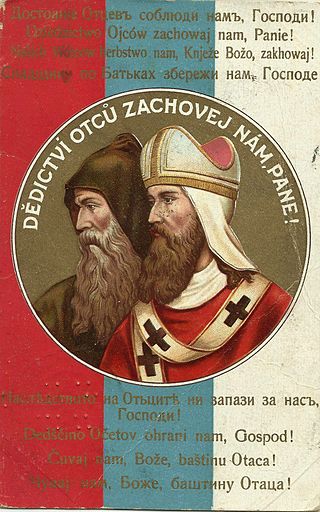
The Slavs were Christianized in waves from the 7th to 12th century, though the process of replacing old Slavic religious practices began as early as the 6th century. Generally speaking, the monarchs of the South Slavs adopted Christianity in the 9th century, the East Slavs in the 10th, and the West Slavs between the 9th and 12th century. Saints Cyril and Methodius are attributed as "Apostles to the Slavs", having introduced the Byzantine-Slavic rite and Glagolitic alphabet, the oldest known Slavic alphabet and basis for the Early Cyrillic alphabet.

Stefan or Stjepan Ilija Verković was a 19th-century Bosnian ethnographer and folklorist. Born to Bosnian Croat parents, he identified as South Slav and initially he supported the Serbian and later the Bulgarian national cause.
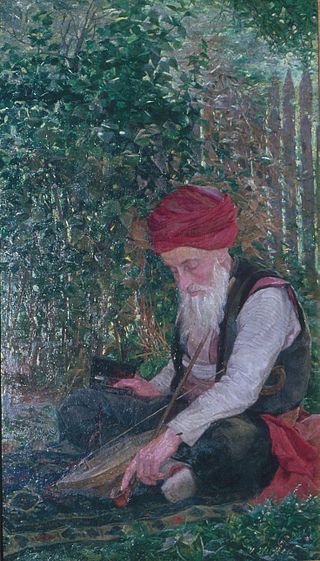
Bosniak epic poetry is a form of epic poetry originating in today's Bosnia and Herzegovina and in the Sandžak region, which is a part of modern-day Serbia and Montenegro. Bosniak epic poetry developed during the Ottoman period. Historically, they were accompanied by the Gusle. The theory of oral-formulaic composition was developed also through the scholarly study of Bosnian epic verse.
